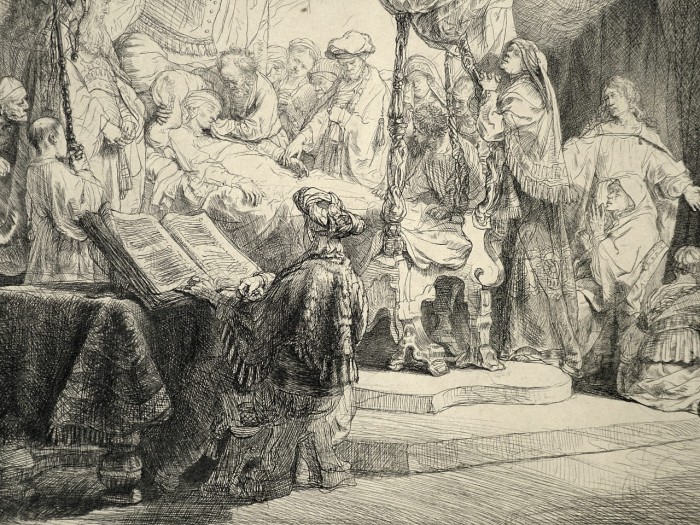The Death of the Virgin
Rembrandt Harmensz. van Rijn (1606-1669), The Death of the Virgin, etching and drypoint, 1639 [signed and dated in the plate]. References: Bartsch, Hollstein 99, Hind 161, second state (of 3). In very good condition (a couple of small fox marks, unobtrusive printer’s creases lower right), printed on sturdy ivory/tan laid paper with a Strasbourg Lily watermark (see discussion below), trimmed just outside of the platemark top and sides, outside of the borderline bottom, 15 5/8 x 12 1/4 inches.
A fine lifetime impression, with traces of drypoint burr on the figures and clothing of figures at the left; also on the chair bottom right, and in numerous places elsewhere.
In the second state Rembrandt added drypoint work on the chair lower right, in the third state he darkened the foreground bedpost with additional drypoint.
Provenance: Kennedy Galleries, NY (with their inventory number verso); unidentified collector (initial N, not in Lugt). Also writing verso in pencil (title, catalogue numbers, the annotation “extremely fine.”)
A Strasbourg Lily watermark is common to the first state and second state impressions of Death of the Virgin (cf. Erik Hinterding, Rembrandt as an Etcher, Catalogue of Watermarks, vol. 2, p. 276; also see Ash and Fletcher, Watermarks in Rembrandt Prints, p. 196); the variation closest to our impression is probably Hinterding’s Strasbourg Lily C.b.a. (cf. Hinterding vol. 2, p. 203) which is found in the second state impression at PCS (Private Collection, Switzerland). Other examples of the second state with this watermark or a close variant (cf. Hinterding p. 276) can be found at the Rijkisprentenkabinet, Amsterdam; the British Museum; The Library of Congress; and the Philadelphia Museum of Art. Hinterding indicates that Rembrandt used paper with this watermark during the period 1633-1641.
In this very large depiction of the death of the Virgin, a story not recounted in the Bible but widely known since the Middle Ages through an account in the Golden Legend, Rembrandt focuses on the movement and expressions of the mourners surrounding the covered bed. A doctor takes Mary’s pulse, while the bald-headed apostle Peter comforts her; a priest stands at the left and a shorter figure (kneeling?) holds a tall pole (much as a kneeling server in Durer’s woodcut of the same subject holds a crucifix and a priest stands to the left). A man sitting in the foreground reads a huge bible. The figures are dressed in vaguely oriental garb, to locate the scene in the ancient Middle East. Above the bed in the clouds an angel appears, surrounded by putti. Rembrandt uses a vast range of techniques in the print, sketching some figures and the clouds lightly, and drawing some figures and structures in great detail and with substantial shading and cross-hatching.

